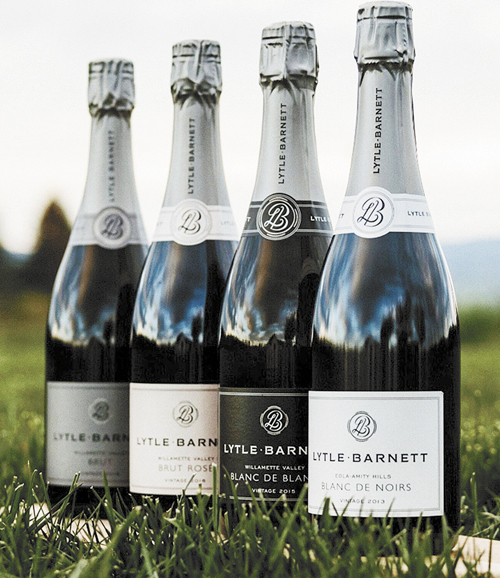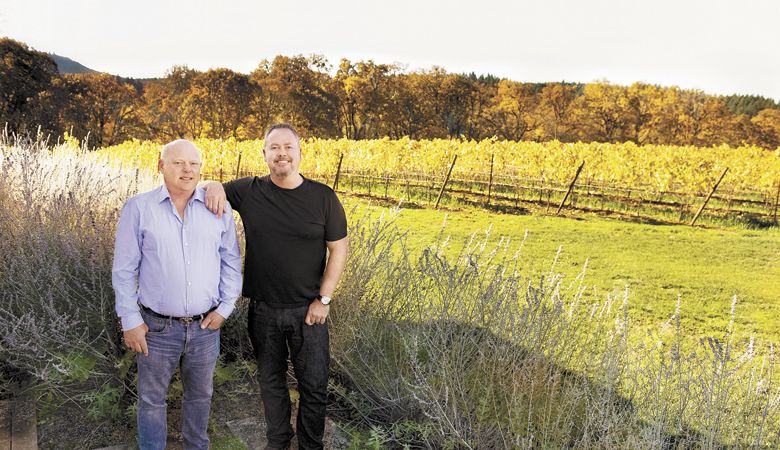Bubbling to the Top
Lytle-Barnett rises to the Champenoise challenge
If recent history is any indication, the Willamette Valley is no stranger to sparkling wine. As the quality continues to rise, and more and more producers join the party, the region long known for still Pinot Noir will be talked about in the same reverential tone for its bubbly.
With so many New World sparkling operations, the French influence abounds; for Lytle-Barnett, the Old World nod is practically a bow. It’s the guiding light for one of the newest arrivals to the Willamette Valley effervescent stage. Co-founder Andy Lytle explains, “My partner, Antony Beck, and I wanted to make high-end sparkling wine in Oregon the same way that the French make vintage méthode Champenoise in Champagne.”
You may recognize the Beck name. Antony Beck’s brand, Graham Beck, remains a serious player in the South African sparkling wine scene. In fact, the winery’s cellar master, Pieter Ferreira, is part of the one-two punch making up Lytle-Barnett’s unique dual winemaker approach. On this particular project, Ferreira works as a consultant with lead winemaker Andrew Davis, founder of Radiant Wine Company. Beck first forayed into the Oregon wine scene in 2006 when he opened Angela Estate in the Yamhill-Carlton AVA.

Lytle-Barnett remains committed to following the protocol of sparkling’s motherland, Champagne, which includes aging in the bottle at least three years. The winery is dedicated to the “look” of traditional bubbles, too, as in a logo evoking those of famous houses in France. Lytle-Barnett’s version, an homage to family, combines the crests of both Lytle and Beck names. “Many brands are simply the last names of the proprietors,” Lytle explained. “That said, we used my last name and Antony’s mother’s maiden name to create Lytle-Barnett.”
The collaboration started in 2013, Lytle-Barnett’s first vintage. Local winemakers remember that year for its monsoon-like rains falling right around harvest, causing serious decision-making in the vineyard and extra care in the cellar. Tending to pick earlier, sparkling producers were spared the unusual September conditions.
Lytle-Barnett crafted about 800 cases the first go-around, opening with a Blanc de Noirs and Brut Rosé that year. In the following vintage, 2014, the label added a standard Brut. In 2015, a Blanc de Blancs was created, a personal favorite of the founders. It’s made entirely of Chardonnay and fermented in a combination of stainless steel and oak.
Early on, the winery sourced fruit from throughout the Valley, but, over time, it has focused on the Eola-Amity Hills AVA. The grapes represent fellow vineyards — Beize, Zenith, Pearlstad — and estate vines within the mid-Willamette Valley appellation. Lytle-Barnett’s Anahata Vineyard, a 24-acre parcel at 500 feet in elevation, is the first of two estates; the latter is projected to be harvest-ready by 2022.
Serendipitously, Lytle connected with Davis in 2013, just as he was beginning his move away from longstanding bubbles icon Argyle and toward his own venture. Lytle notes while Radiant has been immensely popular for Davis, those are all consulting gigs. Lytle-Barnett is the only label where Davis is named the house vintner.
“Andrew and Peter are a powerhouse combo,” Lytle said. “Andrew, the Oregon guru, and Peter, the internationally acclaimed winemaker affectionately nicknamed ‘Bubbles.’ I love the wines we’ve made, but when these two fellas say they’re good, they are.”
What’s in store? The winery has been setting aside small portions of each vintage since 2014 with the hopes of ultimately making a multi-vintage cuvée. Lytle says they dabble in Pinot Meunier as well, a grape known for its blending abilities in sparkling and one that seems to fare quite well in the Willamette Valley. Production has reached around 2,000 to 2,500 cases per year, so availability should be less of an issue going forward as well.
Presently, Lytle-Barnett sells four sparkling offerings. The wines are layered, embodying the detail patient winemaking tends to produce. The Blanc de Blancs is particularly interesting, showing a nice acidity and some signature Chardonnay flavors like lime and almond. The current vintage of that wine, 2015, was recently awarded a 93-point score from Wine Enthusiast. Oregonians are well aware of the variety’s massive potential here but it’s gratifying to be reminded of its complexity in sparkling form, too.
The wine’s price-point is high for Oregon, around $80 a bottle, but the price tag falls in line with French counterparts, in terms of non-vintage Champagne.
An enthusiastic believer in chilled bubbles, Lytle suggests the wines be served straight out of the fridge. As he says, if you like sparkling slightly warmer, just give the pour a few minutes in the glass. It’s much easier going from cold to slightly warmer than vice versa.
Sparkling wine enthusiasts have much to look forward to in Oregon. The state has gone from just a few renegade producers to a genuine scene, thanks to renewed interest, and easier access to specialized equipment and techniques — Radiant Wine Company is a major part of this. With this momentum, we’ll almost certainly be toasting additional newcomers in the vintages to come.
“Our goal is to raise the tide for all sparkling wines in Oregon,” Lytle said. “We really feel that with the quality Pinot Noir and Chardonnay we are getting from the Willamette Valley, especially Eola-Amity [Hills], the time is now to make exceptional sparkling that would rival something you might find from France. All we do is sparkling wine, so we are focused on making the best of the best and leading the way into this ‘golden age’ of sparkling wine.”











